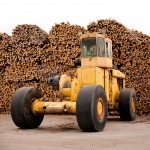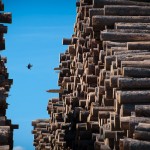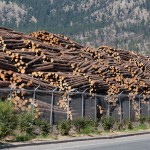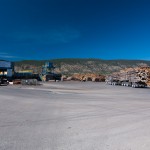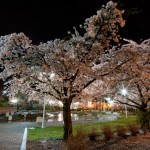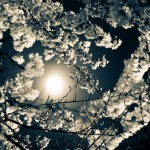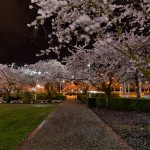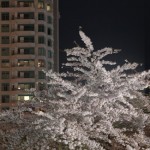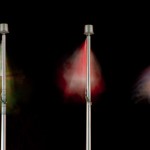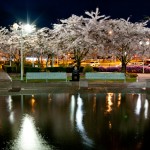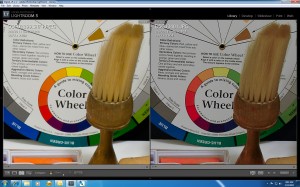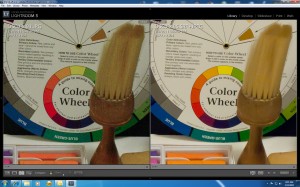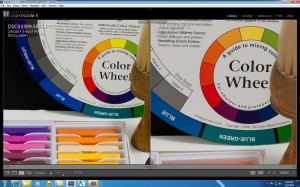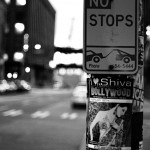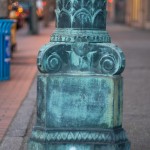Pentax DA 12-24 on film
The Pentax DA series of lenses are designed with an image circle that covers the APSC sized digital sensor. They are not intended to be used on a 35mm film camera, as they create large amounts of vignetting. That almost sounds like a challenge to me. I mounted my DA 12-24 on a PZ1p loaded with Kodak Ektar and experimented. It is immediately apparent that the wide end between 12 and 18 millimeters is out as the lens just doesn’t come close to covering the film frame. You can see this immediately in the viewfinder. However between 18 and 24mm and with the lens adequately stopped down to about f11 you can actually use this lens as an ultra wide zoom on film. Converting the image size factor around from 35mm to APSC means the 18mm on 35mm film is about equivalent to 12mm on APSC.
Here you can see what happens if you don’t stop down enough, although I think this shot was taken with the DA 35mm ltd with the lens hood deployed.
Bokehmon 2 the images
These are the sample images to go with the post Bokehmon (Takumar 200 3.5) , with the last three from the SMC Takumar 55 1.8
Bokehmon
OK I only have the vaguest of ideas of what I just referenced but it sounds good. I took some more images with the 200mm 1:3.5 Takumar as well as the 55mm 1:1.8 SMC Takumar mounted to my Pentax K10D. The 200mm lens has 18 aperture blades that form a near circle. Contrast this to a lens with only 5 blades and you can see the reason why the out of focus areas are so smooth and have that quality referred to as good Bokeh.
Being an older lens it doesn’t have the coatings the help to mitigate internal reflections and flare so I’ve used that fact to highlight it and give that feel of yesteryear to some of my images. I will show some more images in a future post.
Takumar
I decided to go all retro with my lenses. I went for a walk and took: 28mm 1:3.5 Super_Takumar, 35mm 1:2.3 Auto-Takumar, 55mm 1:1.8 SMC Takumar and the 200mm 1:3.5 Takumar. All of these are manual focus manual exposure lenses that I mounted to my Pentax K-7. It’s hard to define the look of these lenses but they are different than a modern one that is corrected for distortion. Some of the distortion I think actually adds to the look rather than detracting. The 35mm 2.3 has an unusual effect on out of focus areas creating a kind of swirling vortex of blur. The 200mm has pronounced chromatic abaration creating a kind of halo around bright objects. All these effects are what we see when we look at older photographs and there really is no way to re-create them with processing or apps.

Mission BC in the rain.
I had a difficult time keeping dry while I snapped a few shots in the nearby community of Mission. I had my Pentax ME super tucked inside my jacket with a SMC 40mm 2.8 lens on it. It was nice to use an SLR instead of a point and shoot or a rangefinder for the ability to preview the image in the viewfinder. I really change cameras too often to be able to get a solid sense of how any one of them will frame a scene from what I am seeing in the viewfinder.
#Blossoms at night.
I noticed these trees when I was at the Reach gallery in Abbotsford. I’ve taken my share of blossom pictures in the daylight so I thought I would try some nocturnes. I returned after the gallery opening for the current show. It’s one thing to look at a print in a book but it’s wonderful to actually stand in front of the real thing, I’m speaking in particular about Betty Goodwin’s vest prints. Anyway back to the original point, I returned with my Pentax K-7 and took about 60 images varying focal lengths, exposures and even overlaying multiple images. So here are some of the better results of my experiments.
Why I shoot RAW
I shoot RAW with my DSLR and my compact camera, because it allows me to get the maximum out of the sensors with the most up to date processing. Shooting jpeg sets the image processing with what is available at the time by the camera manufacturer and usually doesn’t allow for much improvement. Here are some comparison images at 100% magnification both between RAW and Jpeg and comparing the Sony DSC-V3 to my Pentax K-7. I did these tests for my self but thought I would share the results no matter how esoteric.
Sony DSC-V3 100ISO RAW vs jpeg (File size 1.16 Mbyte)
Sony DSC-V3 800ISO jpeg vs RAW (File size 1.4 Mbyte) This is where the differences are most apparent
DSC-V3 vs Pentax K-7 at 100 ISO Both RAW
Pentax FA 50 1.4
Here are some example images of the Pentax FA50 shot wide open, an F-stop of 1.4, using the K-7 DSLR. Having a lens this fast is nice as it allows you to maintain faster shutter speeds as the light level drops. It also provides a very shallow depth of field that can be used to isolate an element in an image.
